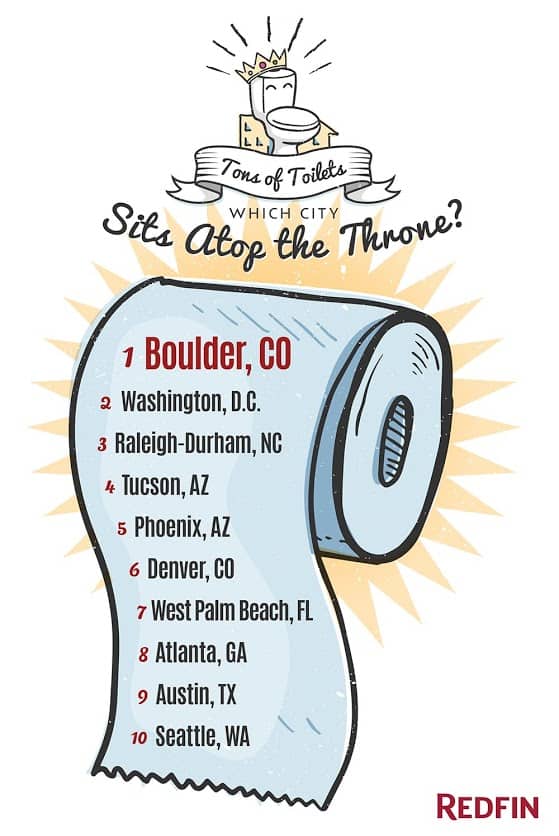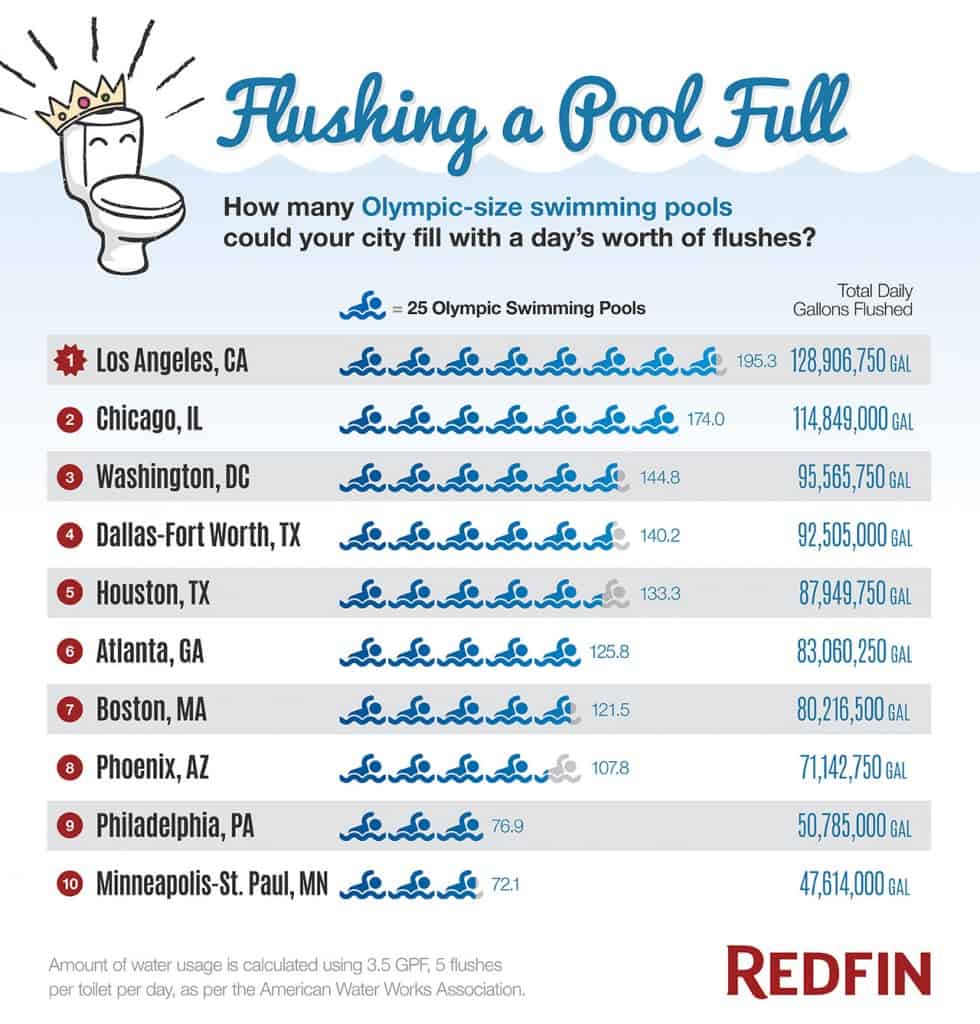
So, where can you sit at your leisure?
Using census and housing data, we calculated which cities had the most residential toilets per person and we had a clear winner: Boulder, Colorado. Boulder is the only city with more residential toilets than actual people. For every 100 Boulderites, there are an estimated 102 residential toilets. That’s 305,200 total toilets, which use 5,341,000 gallons of water per day (for more on water use, see our chart and infographic below). In other words, if you’re home shopping in Boulder and can’t find a three-bedroom home with three bathrooms, you’re doing something wrong.
How many toilets are in your city?
While only Boulder has more toilets than people, all of our Top 10 finishers were flush with porcelain: None had fewer than 91 toilets per 100 residents.
Plunging deeper into the numbers, there were 83 toilets per 100 residents across all 37 markets surveyed and the variance by city was significant. In a few cities, like Miami and Philadelphia, you’d have to stage a coup d’loo to get some throne time.
Check out the chart below to see how your city handles its business.
| Metro | Toilets per 100 people |
Total toilets | Gallons flushed per day |
|---|---|---|---|
| Boulder, CO | 102 | 305,200 | 5,341,000 |
| Washington, DC | 98 | 5,460,900 | 95,565,750 |
| Raleigh–Durham, NC | 98 | 1,559,600 | 27,293,000 |
| Tucson, AZ | 95 | 920,100 | 16,101,750 |
| Phoenix, AZ | 94 | 4,065,300 | 71,142,750 |
| Denver, CO | 94 | 2,384,800 | 41,734,000 |
| West Palm Beach, FL | 93 | 1,257,800 | 22,011,500 |
| Atlanta, GA | 92 | 4,746,300 | 83,060,250 |
| Austin, TX | 91 | 1,652,700 | 28,922,250 |
| Seattle, WA | 91 | 2,485,000 | 43,487,500 |
| Las Vegas, NV | 89 | 1,790,800 | 31,339,000 |
| Portland, OR | 89 | 1,965,900 | 34,403,250 |
| Charlotte, NC | 88 | 1,595,900 | 27,928,250 |
| Hampton Roads, VA | 88 | 1,323,800 | 23,166,500 |
| Hudson Valley, NY | 87 | 1,179,700 | 20,644,750 |
| Tacoma, WA | 86 | 688,900 | 12,055,750 |
| Tampa, FL | 86 | 2,440,100 | 42,701,750 |
| Boston, MA | 85 | 4,583,800 | 80,216,500 |
| Minneapolis–St. Paul, MN | 85 | 2,720,800 | 47,614,000 |
| San Diego, CA | 84 | 2,633,300 | 46,082,750 |
| San Francisco, CA | 84 | 1,516,000 | 26,530,000 |
| Orlando, FL | 83 | 1,843,300 | 32,257,750 |
| Sacramento, CA | 83 | 1,801,200 | 31,521,000 |
| Providence, RI | 83 | 2,454,300 | 42,950,250 |
| Houston, TX | 82 | 5,025,700 | 87,949,750 |
| Dallas–Fort Worth, TX | 80 | 5,286,000 | 92,505,000 |
| Ventura County, CA | 79 | 655,400 | 11,469,500 |
| San Jose, CA | 78 | 1,423,300 | 24,907,750 |
| Chicago, IL | 78 | 6,562,800 | 114,849,000 |
| Baltimore, MD | 77 | 2,030,800 | 35,539,000 |
| Los Angeles, CA | 75 | 7,366,100 | 128,906,750 |
| Long Island, NY | 75 | 2,100,000 | 36,750,000 |
| Philadelphia, PA | 74 | 2,902,000 | 50,785,000 |
| Orange County, CA | 73 | 2,237,200 | 39,151,000 |
| Riverside–San Bernardino, CA | 71 | 3,050,000 | 53,375,000 |
| Fort Lauderdale, FL | 71 | 1,298,200 | 22,718,500 |
| Miami, FL | 62 | 1,600,800 | 28,014,000 |
Why do some metro areas have more toilets than others?
“It’s definitely a consumer-driven trend,” explained Redfin agent Leslie White in Washington, D.C. “I don’t know when it took place, but having a master bathroom off the main bedroom is now seen as a requirement, whereas years ago, it was considered a luxury. I’ve toured lovely 100-year-old row houses, but if there’s only one bathroom for the three bedrooms on the top floor, my clients’ faces fall. They need that extra bathroom.”
Atlanta agent Tammy Trenholm said it can go one step further in her market: “Most people are familiar with the concept of a master bathroom. But a lot of our clients won’t buy unless there’s also a ‘princess suite’ – the term for a second bedroom with its own private bathroom.”
In fact, in areas with the growth and economy to support new residential development, the demand for toilets is lifting the lid. Indeed, all of our top-10 cities have had decades of net positive migration and sit in regions (the South and West) with more housing starts than the rest of the country. “If you want to sell or resell a home quickly, it needs to have what people want,” White said, “so even older three-story homes in D.C. often now have at least one bathroom per floor, in addition to the master bath. In our area, there’s the money and desire to add them in.”
Even our last-place finisher, Miami, which has a piddling 62 toilets per 100 residents, is the exception that proves the rule. “Miami was one of the first places to have large-scale condos,” said Redfin agent Bohdan Mastykaz. “A lot of our condo stock was built in the 1960s and 1970s – and with fewer bathrooms than you’d have today. The idea was to build for empty-nesters looking to downsize, and so you’d have a one-bed, one-bath that a couple would share, or even a two-bed, one-bath unit. Builders were selling practicality. As of yet, there’s not the urge to tear down or gut these buildings – we’re talking 200 to 400 units in a building, where most people are still reasonably comfortable.
“Things are changing, though,” Mastykaz said. “Now, like many cities, new condos are focused on luxury. There are 19,000 new units in 120 skyscrapers in progress – and these are all at least two-bedroom, two-bathroom units. Since about 1990, builders haven’t been interested in going any smaller. So if you were to look at Miami in 10 or 15 years, our profile would include many more bathrooms.”
What about the water?
Potty talk may seem childish, but the resources used for modern plumbing are serious business. We realize that toilet usage varies greatly by household size and amount of time spent in the home, but if the average residential toilet was flushed just five times a day (a rough estimate based off of an American Water Works Association study), how much water would all of a city’s residential toilets use? We estimate that the average flush uses 3.5 gallons of water (see methodology below). If all this water were diverted to a series of Olympic-size swimming pools, how many would it fill?
The infographic below looks at the 10 cities that use the most water per day. And, lest an unwary reader believe that an Olympic pool doesn’t have that much water, think again. Olympic pools are 50 meters long and hold 660,000 gallons of water, or approximately 36 times the water used in a typical backyard pool.

Methodology: To calculate the number of toilets in each of 37 Redfin markets, we looked at the most recent household and population data from the American Community Survey, along with county recorder data on the number of toilets present in each residence. Each market includes the city and surrounding metro area.
In our Olympic pool calculations, we arrived at an average of 3.5 gallons per flush. Here’s how: In 1994, the Energy Policy Act of 1992 (EPAct) went into effect, requiring that all newly-manufactured residential toilets use a maximum of 1.6 gallon per flush (GPF). And with recent advances, some modern toilets use only 1.28 GPF. So, why do we estimate such a high GPF? Prior to EPAct, most toilets used 3.5 gallons per flush, while some used 5 GPF, or even 7 GPF. And, of course, there remain a lot of older homes, which often have older toilets. The median of all five types of toilets is 3.5 GPF, which strikes a fair balance as we transition from water-heavy toilets to high efficiency.
How does your city fare when it comes to toilets and water usage? Tell us what you think on Facebook, Twitter, G+, or in the comments below.



























 United States
United States Canada
Canada